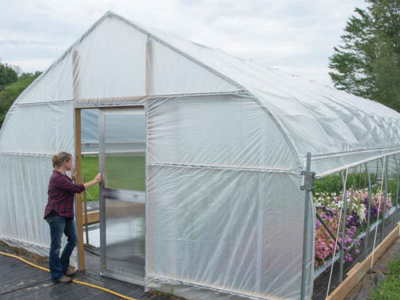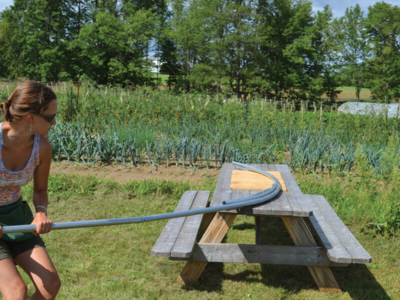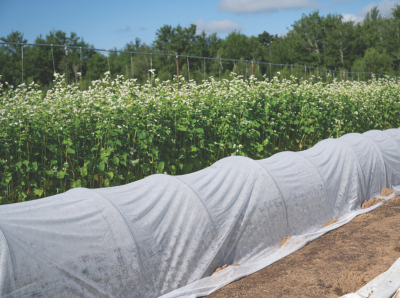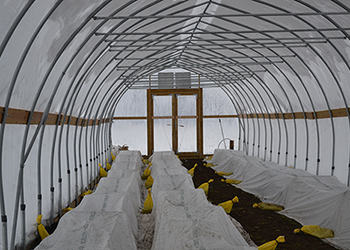- 10 Ways to Extend Your Season with Protected Cultivation
- QuickHoops Gothic High Tunnel Bender | Construction Manual for Modular Moveable Gothic High Tunnel (PDF)
- QuickHoops Gothic High Tunnel Bender | Construction Manual for Stationary Gothic High Tunnel (PDF)
- QuickHoops High Tunnel Bender | Construction Manual for Building a Stationary High Tunnel (PDF)
- QuickHoops Low Tunnel Benders | Instruction Manual (#9377 & #9520) | (PDF)
- Agribon+ AG-19, 30, 50 & 70 Row Cover | Insert (PDF)
- Hitch Mount for QuickHoops Low Tunnel Benders | Instruction Manual (PDF)
- Bobcat Automatic Ventilation Kit Manual (#6791) | Tech Sheet (PDF)
- Bobcat Pro High Tunnel Kit Manual (#6794) | Tech Sheet (PDF)
- Bobcat Pro High Tunnel Kit (#6794) | Parts List (PDF)
- Bobcat Sliding Door Kit Manual (#6792) | Tech Sheet (PDF)
- Bobcat Standard High Tunnel Kit Manual (#6795) | Tech Sheet (PDF)
- Bobcat Standard High Tunnel Kit (#6795) | Parts List (PDF)
- Bobcat Steel End Wall Kit Manual (#6793) | Tech Sheet (PDF)
- Truss Support Kit Manual (#6790) | Tech Sheet (PDF)
- Bobcat Tunnel Kits | Comparison Chart
- Beginning & Intermediate Controlled Environment Agriculture (CEA) | Advances in Greenhouse Crop Production
- 5 Cool Flowers to Plant Now | Lisa Mason Ziegler's Secrets for Growing Hardy, Cool-Season Annuals
- Hoop Loops | Installation Instructions | Tech Sheet (PDF)
- Introduction to Overwintering Flowers | Guide to Overwintering Flowers
- Overwintering Perennial Herbs
- Protect Your Crops | High & Low Tunnel Basics
- The Effect of Shorter Daylength on Winter Production
- Be First & Last to Market by Extending Your Growing Season
- Quick Hoops Low Tunnels | Set-up & Management with Eliot Coleman
- Constructing the Modular Moveable Gothic Tunnel – Animated Schematic
- Moving the Modular Moveable Gothic Tunnel – Slideshow
- Skinning the Modular Moveable Gothic High Tunnel – Slideshow
- Overwinter Flower Trials | Multiyear Results for 30+ Crops | Johnny's Selected Seeds | XLSX
- Seeding Date Calculator | Johnny's Recommended Flowers for Overwintering | XLSX
- Overwintering Onions from Seed | Johnny's Selected Seeds
- Winter Growing Guide | Part 5: Overwintering Planting Dates
- Pest & Disease Control Basics in Greenhouse, Hydroponic & Other Protected-Culture Systems
- Pests & Diseases of Greenhouses & Hydroponic Systems | Tech Sheet (PDF)
- Why & What to Grow in a Greenhouse? Basics of Protected Culture
- Recommended Varieties from Our Greenhouse Trials | What We Look for in Greenhouse Crops
- QuickHoops 3'W x 4.5'H Low Tunnel Bender (#7616) | Instruction Manual (PDF)
- Cable Purlin Trellis for QuickHoops High Tunnels | Installation Manual (PDF)
- QuickHoops Moveable High Tunnel Bender | Instruction Manual (PDF)
- QuickHoops Seedling & Microgreens Bench | Construction Guide (PDF)
- Row Cover & Insect Netting Options & Uses | Comparison Chart (PDF)
- Tufflite IV Greenhouse Film | Comparison Chart (PDF)
- Univent Automatic Opener for BiFold Doors | Instruction Manual (PDF)
- Video: Johnny's Season Extension & Overwintering Trials
- Video: Planning & Planting the Autumn Vegetable Garden | Tips & Recommendations with Niki Jabbour
- Video: Veggie Remix: Bring New Flavors & Colors Into Your Garden | Johnny's Webinar Series
- Video: Growing Under Cover with Niki Jabbour | Johnny's Webinar Series
- Video: Cover Cropping for Field & Garden with Collin Thompson | Johnny's Webinar Series
- Video: Tips & Crop Recommendations for the Autumn and Winter Cold Frame • Tutorial with Niki Jabbour
- Video: DIY Cold Frame • Easy How-to Tutorial with Niki Jabbour
- Video: How to Use Quick Hoops™ Benders to Create High & Low Tunnels
- Video: The Benefits of Row Covers | Recommendations & Tips
- Video: Hoop Houses & Other Ways to Extend Your Growing Season
- Video: Take a Tour with Us of Johnny's Greenhouses!
- Growing Under Cover with Niki Jabbour & Johnny's | Johnny's Educational Webinar Resources
- Johnny's Winter Growing Guide | Printable Brochure (PDF)
- Winter Growing Guide | Part 2: Production in the High Tunnel
- Winter Growing Guide | Part 1 - Introduction
- Winter Growing Guide | Part 3: Overwintering in Low Tunnels
- Winter Growing Guide | Part 6: Recommended Crops & Varieties
- Winter Growing Guide | Part 4: Planting Dates for a Winter Harvest
- Choosing Flower Crops to Overwinter | Guide to Overwintering Flowers
- When to Start Seeds for Overwintered Flowers | Guide to Overwintering Flowers
- Gardening in a Cold Frame With Niki Jabbour
- Webinar Slide Deck | Overwintering Flowers | 41-pp PDF
- Video: Irrigation Considerations for the Overwinter Flowers Tunnel | Johnny's Selected Seeds
- Video: Winter Sowing & Milk-Jug Greenhouses | With Niki Jabbour & Johnny's
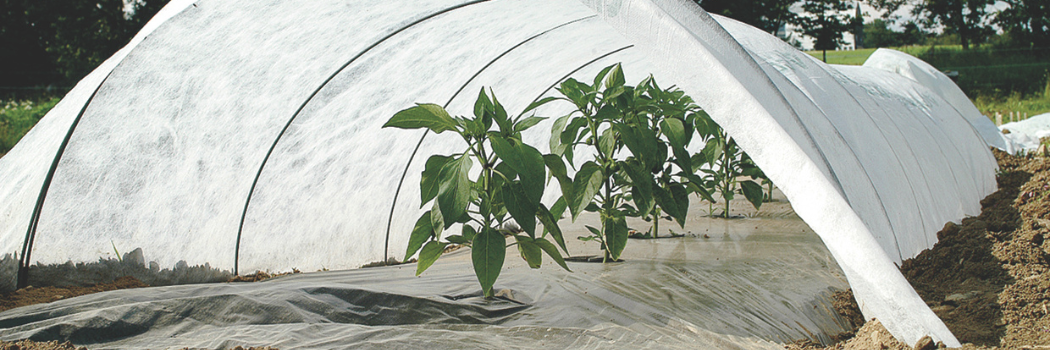
Protect Your Crops • Basic High & Low Tunnel Components
by Lynn Byczynski, Author & Founder of Growing for Market with updates from the Johnny's Research TeamHigh tunnels, low tunnels, row covers, and mulches can be used to protect crops from bad weather and to extend the season for months, while increasing yields and improving quality of vegetables, fruits, herbs, and flowers.
High Tunnels/Hoophouses
The ultimate tool in protected cropping is a high tunnel (also called a hoophouse), which is an inexpensive, unheated greenhouse erected right in the field. Hoophouses have become an essential component of most produce and flower farms. A single layer of greenhouse poly over metal or PVC hoops, tall enough to walk into, provides an amazingly different growing environment. Hoophouses don't need electricity or heating systems, although some growers do add them to extend the season even further. In general, though, roll-up or roll-down sides are used to ventilate a hoophouse, and the sun does the work of heating it.
Some of the crops that are commonly grown in a hoophouse include lettuce and greens, early and late in the year; strawberries in spring; raspberries and tomatoes in summer; and spinach and other cold-hardy vegetables over the winter. Many other crops will benefit from the protection, depending on regional variations. With careful crop selection, a hoophouse can be the most productive land on a farm.
Johnny's offers two types of high tunnel options:
- Bobcat kits—durable and easy to assemble, professional grade kits.
- QuickHoops High Tunnel Benders—benders are a very economical way to construct a high tunnel. Use the bender to shape 1 3/8" galvanized chain link fence top trail (easily sourced at your favorite building supply store), then build the structure according to the included plans.
Low Tunnels
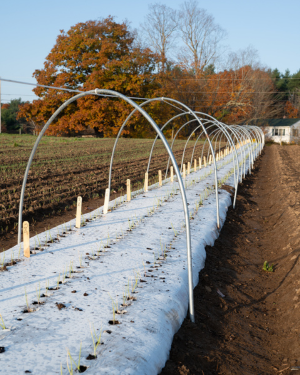
Low tunnel on the Johnny's Research Farm, planted with overwintering onions.
Another protected cropping tool is a low tunnel. Low tunnels are made of hoops, pushed into the soil over a bed of crops, and covered with either spun-bonded polypropylene row covers or greenhouse plastic.
Like high tunnels, low tunnels warm the soil and protect plants from frost and wind. They can be used early in spring for cool-weather crops, in late spring to give a head start to warm-weather crops such as tomatoes and peppers, and again in fall to keep cool-weather vegetables growing longer. They also are useful for protecting crops from predictable insect pests such as flea beetles and cabbage moths.
Low tunnels are easier to assemble and disassemble than high tunnels, and are lower cost, but they offer less protection than a full-size high tunnel. We've found that hoops fashioned from EMT (electrical metal conduit) are much sturdier and longer-lasting than PVC, and thus more economical across time.
Johnny’s offers the Quick Hoops™ low tunnel benders as an easy, affordable DIY low tunnel construction. Quick Hoops™ low tunnel benders are available in 3’, 4’, and 6’ widths.
Hoops + Row Cover
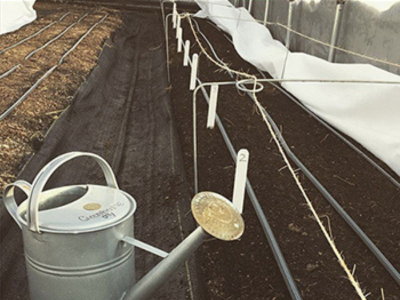
Twine is run through the loops in our Hoop Loops; the twine provides increased row cover support and allows for a wider spacing between hoops.
The quickest and simplest way to cover your crops is to use wire hoops and row cover. There are a few options for hoops:
- Wire hoops made from #10-gauge galvanized steel—available in 54” and 76” widths.
- Hoop Loops, which are wire hoops with built-in loops for running twine through hoops along the bed. The twine provides increased support for the row cover. Available in 16”, 26”, and 32” widths.
- Make DIY hoops with Coiled #9 Support Wire.
Row Cover Uses & Grades
Row covers provide crop protection while still allowing water and light to permeate through to the crop. The degree of temperature mediation and light transmission that the row cover provides depends on the thickness and material.
For Frost Protection
Row cover alone can be pulled over crops to save them from untimely frosts. Late and early frosts are often one-night affairs; protecting against those relatively short-lived dips in temperatures can keep crops alive for several additional weeks of good growing conditions. Most growers keep a supply of row cover on hand for just such emergencies.
Row covers can also be used inside high tunnels for an added layer of protection for overwintered crops. For example, we use a layer of Agribon+ AG-70 over many of our overwintering high tunnel flower crops.
We recommend Johnny's DuraSpun™ 55 or Agribon AG-19 for general frost protection. Heavier weights for overwintering are also available. As you might expect, light transmission decreases with the weight of the row cover; heavy-weight row covers that provide the highest degree of frost protection also transmit the least light.
- For more information about row cover grades and their levels of frost protection, see our Row Covers Comparison Chart
For Insect Protection
Low tunnels or wire hoops in combination with insect barrier can also be used to protect crops from insect pests and birds during the growing season. Insect barrier has a tight enough weave to exclude insects but allows sufficient light, air movement, and rainfall through to support crop growth. This is a good option for growers wishing to reduce their use of pesticides.
- Compare insect protection in our Row Covers Comparison Chart
For Sun Protection
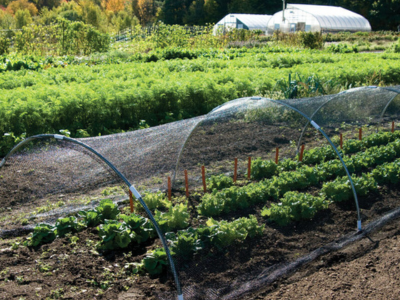
Knit shade cloth over hoops secured with snap clamps. Shade cloth helps reduce heat stress by blocking light transmission.
Shade cloth cools crops by blocking light transmission. It is more porous than standard row cover, which means better ventilation and water permeability for summer crops. Shade cloth can be laid over hoop loops, low tunnels, or high tunnels to block sunlight and cool crops.
- See our Shade Cloth Comparison Chart to choose the amount of light permeability for your needs.
Securing Row Cover
There are several options for securing row cover: sandbags, 8" x 8" x 8" concrete blocks (available at hardware stores), hand pegs, and snap clamps. You can also bury the edges of your row cover to secure it.
Mulches & Landscape Fabric
Plastic or paper mulches are another component of protected cropping systems, often used in combination with high or low tunnels or on their own in the field. Black solar mulch warms cold soil; white-on-black mulch keeps soil cool. Biodegradable and paper mulches eliminate the need to take them up at season's end. All types suppress weeds, reducing labor.
Learn More
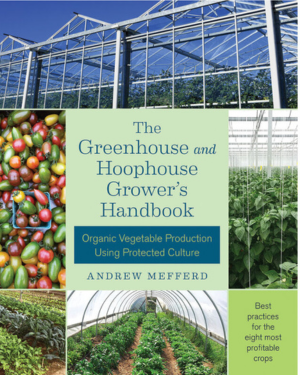
Learn more about protected culture in The Greenhouse and Hoophouse Grower's Handbook by Andrew Mefferd.
By employing some or all of these protected cropping systems, growers can take some of the risk out of farming and gardening. For more ideas about hoophouse production, explore the following resources:
Bobcat High Tunnel Kits
- Bobcat High Tunnel Kits • Comparison Chart
- #7543 • Bobcat Standard High Tunnel Kit Manual • Tech Sheet (PDF)
- #7544 • Bobcat Pro High Tunnel Kit Manual • Tech Sheet (PDF)
Quick Hoops™ Stationary High Tunnels
Quick Hoops High Tunnel Bender (#9018)
Quick Hoops™ Moveable Caterpillar High Tunnel
-
Quick Hoops Moveable Caterpillar High Tunnel Bender (#7000)


